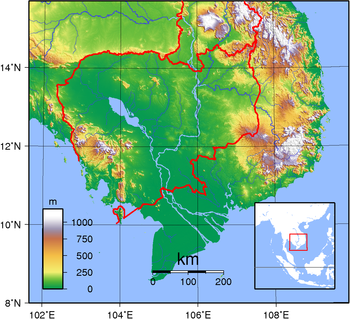Climate in Cambodia: A Complete Guide to Weather, Seasons, and Travel Tips

Introduction
Cambodia, a Southeast Asian country known for its ancient temples, vibrant culture, and stunning landscapes, has a tropical monsoon climate. Understanding the climate in Cambodia is essential for travelers, expats, and business owners looking to make the most of their time in the Kingdom of Wonder. In this guide, we explore Cambodia’s weather patterns, seasons, regional climate variations, and the best time to visit, along with travel tips to help you plan your trip effectively.
Cambodia’s Climate Overview
Cambodia experiences a tropical climate characterized by high temperatures and humidity throughout the year. The country’s weather is primarily influenced by the monsoon seasons, which bring distinct wet and dry periods. The overall climate is divided into three major weather components: temperature, humidity, and precipitation.
Average Temperature in Cambodia
The average temperature in Cambodia ranges from 24°C to 35°C (75°F to 95°F). The hottest months typically occur between March and May, while the coolest period falls between November and January. The country experiences relatively stable temperatures throughout the year, though regional variations exist.
Humidity Levels
Cambodia has high humidity levels, typically ranging from 65% to 90%. The highest humidity is recorded during the rainy season, particularly in the months of June to September. Coastal regions like Sihanoukville and Kampot tend to experience even higher humidity levels.
Rainfall Patterns
Rainfall in Cambodia is heavily influenced by the monsoon. The annual precipitation varies from 1,000 mm (39 inches) in inland areas to over 4,000 mm (157 inches) in mountainous and coastal regions. The wettest months are typically July, August, and September, with frequent afternoon showers.
Cambodia’s Seasons
Cambodia has two main seasons: the dry season and the rainy season, but these can be further broken down into specific periods.
1. Dry Season (November – April)
- Cool Dry Period (November – February): Characterized by comfortable temperatures, lower humidity, and minimal rainfall. This is the peak tourist season, making it the best time to visit Cambodia. Average temperatures range between 22°C and 30°C (72°F to 86°F).
- Hot Dry Period (March – April): Temperatures can soar above 38°C (100°F), making it the hottest time of the year. Regions such as Battambang and Siem Reap tend to be particularly warm. Travelers should be prepared for intense heat and possible drought conditions.
2. Rainy Season (May – October)
- Early Rainy Season (May – June): Light to moderate rainfall with increasing humidity. Temperatures remain high, but brief showers bring occasional relief from the heat.
- Peak Monsoon (July – September): Heavy rainfall, particularly in the afternoon and evening, with increased humidity. Flooding is common in certain areas, especially Phnom Penh and rural lowlands.
- Late Rainy Season (October): Rainfall starts to decline, and the landscape remains lush and green. This transition period is ideal for budget travelers looking to avoid crowds.
Regional Climate Variations in Cambodia
While Cambodia generally experiences similar climatic conditions nationwide, regional differences exist:
- Coastal Regions (Sihanoukville, Kep, Kampot): Higher humidity and more rainfall compared to inland areas. Cooler sea breezes provide relief from heat.
- Northern Highlands (Ratanakiri, Mondulkiri): Slightly cooler temperatures, particularly in the evenings. Rainfall is more abundant due to the mountainous landscape.
- Central Plains (Phnom Penh, Siem Reap, Battambang): The hottest regions in Cambodia, experiencing extreme heat during the dry season.
Best Time to Visit Cambodia
The ideal time to visit Cambodia depends on your preferences:
- November to February: Best for sightseeing, Angkor Wat exploration, and outdoor activities due to cooler and dry conditions.
- March to May: Good for experiencing Cambodian festivals, such as Khmer New Year, but be prepared for intense heat.
- June to October: Perfect for eco-tourism, enjoying waterfalls, and experiencing Cambodia’s countryside at its most vibrant. Budget-conscious travelers will find better deals during this period.
Climate Considerations for Travelers
- Clothing: Wear lightweight, breathable clothing during the dry season and bring rain gear for the rainy months. If visiting highland areas, carry a light jacket for cooler nights.
- Sun Protection: Sunscreen, hats, and sunglasses are essential due to Cambodia’s strong sun exposure.
- Hydration: Stay hydrated, especially during the hot season, as dehydration is a common issue.
- Mosquito Protection: The rainy season increases mosquito activity, so carrying insect repellent is recommended.
- Flooding Awareness: If traveling during the rainy season, be aware of possible flooding in rural areas and city streets.
Conclusion
Cambodia’s tropical climate offers different experiences throughout the year. Whether you’re visiting for the ancient wonders of Angkor Wat, the bustling streets of Phnom Penh, or the tranquil beaches of Koh Rong, understanding the weather will help you plan a memorable trip. Each season has its unique charm, from the cool, dry months ideal for exploration to the rainy season’s lush greenery. Be sure to check seasonal forecasts before traveling and enjoy all that Cambodia has to offer.
For more expert travel guides on Cambodia, stay tuned to our blog and plan your adventure wisely!
